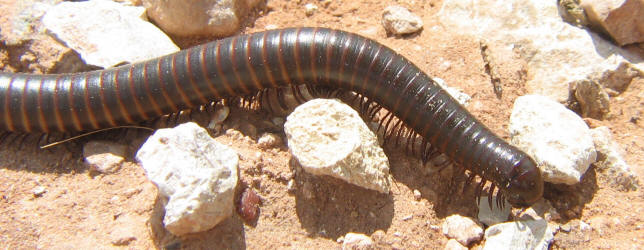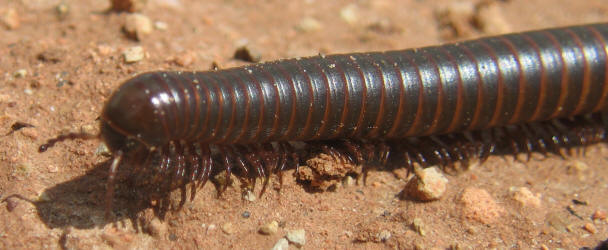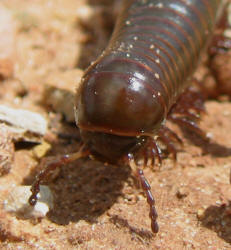Welcome to Catnapin's
Other Arthropod Gallery
Millipede & Centipede
class Diplopoda (Millipede & Centipede)
Millipedes usually have rounded segments with two pair of legs per segment (except head and a few first segments). Their first defense is to curl-up. They do not have poisonous claws but do produce a fluid that stinks. Some people have allergic reactions to the fluid. Millipedes are vegetarian with a main diet of decaying organic matter. Millipedes molt and can gain several segments each time. They can also live many years.
Centipedes have flattened segments with one pair of legs per segment. These animals "bite" with a pair of modified legs. Each leg ends in a poison covered claw. The pain is like a bee sting but can cause severe allergic reactions. Centipedes can live several years. They are primarily insectivores but will eat other small animals.




order Spirostreptida Family Spirostrepidae
American Millipede Narceus americanus
Very common in the Eastern half of North America. Segments are black or dark brown with colored edges: red, orange, yellow, purple, pink. They can grow very large.
Photos taken in Taylor County, August 2008
Other Species in My Area
Desert Millipede Orthoporus ornatus
Common in southern deserts of North America. Segments come in a variety of colors but are not strongly banded. They can grow to 10" long.
Giant Desert Centipede Scolopendra heros
The body color is variable: black or orange, sometimes both. Legs are long and yellow. Head is red. They can grow to 5" long. Very fast.
House Centipede Scutigera coleoptrata
Supper long legs making the animal appear oval. The only species that reproduces in houses (needs dampness).
Texas Tiger Centipede Scolopendra polymorpha
Color is yellow-brown with black bands. Legs are not as long as S. heros but body can reach 6 1/2" long